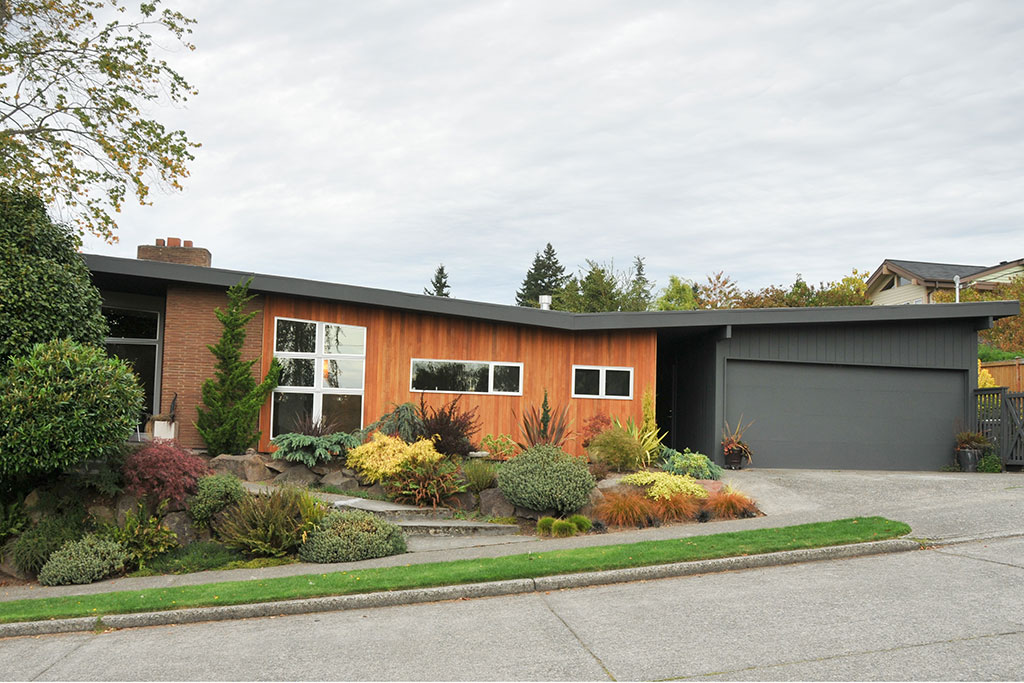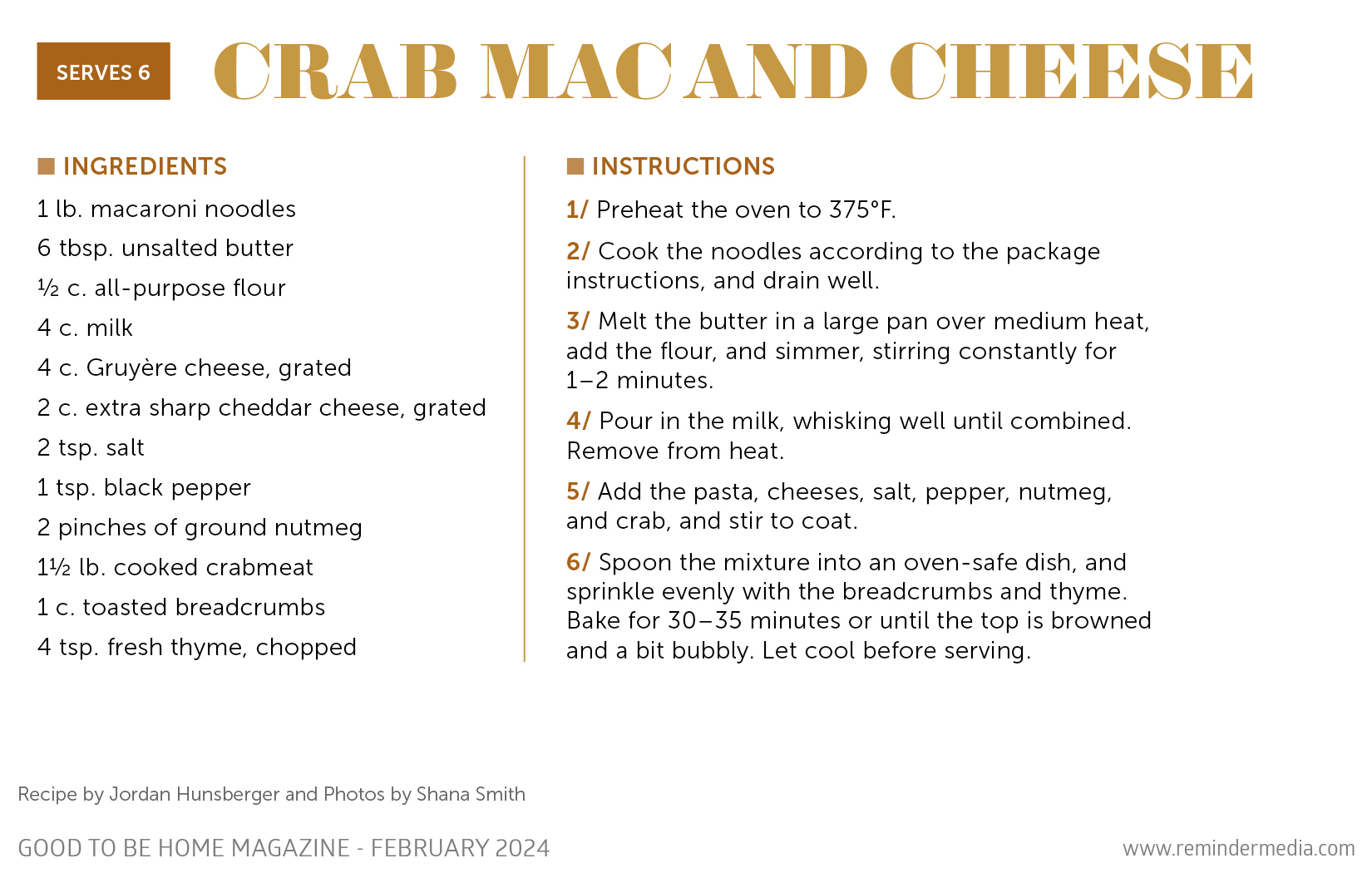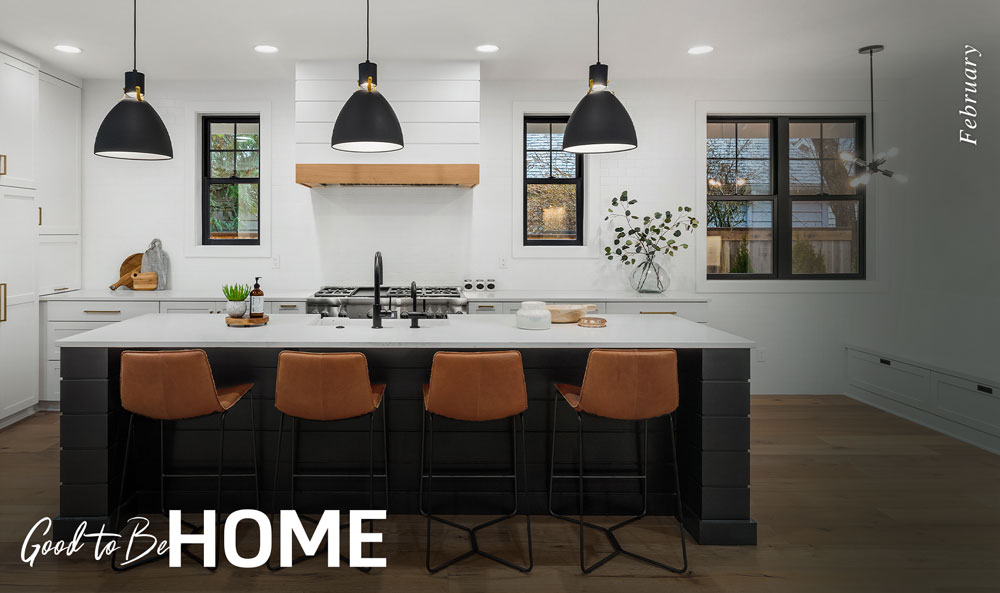February is the month of love, and this issue of Good to Be Home is filled with ways to show your home a little extra TLC in the coming weeks. Inside, discover how built-in furniture can improve functionality, the pros and cons of different home architectural styles, three delicious recipes perfect for your next game-day gathering, and ways to make your fireplace mantel a perennial centerpiece.
From bookcases and bureaus to closet systems and desks, built-in furniture can create a seamless home design that combines practicality with aesthetics. The guide in this issue breaks down the many benefits of these pieces and how they can make your home a more functional and elegant space.
When house hunting, you’ll likely encounter a variety of architectural styles, including Cape Cod, Craftsman, and traditional rancher, each of which comes with its own benefits and limitations. Inside, explore the different options and learn how to find the right one for you and your lifestyle.
It’s always fun to have family and friends over for the big game, but you may be left debating the best food to serve. This issue includes the perfect lineup of recipes—for zesty fry dip, pepperoni pizza dogs, and crab mac and cheese—that are sure to keep your guests cheering for more.
If you’ve ever pondered how to make the most of your fireplace mantel throughout the year, you’re not alone. While you may have numerous adornments at hand for the holidays, crafting a year-round display can be more complex. The strategies inside can help you transform your mantel into a captivating centerpiece regardless of the season.
Here’s hoping you have a lovely month spent with those who mean the most to you! As always, it’s a pleasure to send you this magazine.
A seamless home design is one that perfectly marries everyday practicality with appealing aesthetics. Almost nothing achieves this balance as well as built-in furniture—features such as cabinets and desks that sit flush with walls, fill alcoves, and bridge awkward gaps for streamlined visuals that please the eye. Add to that the structural integrity of furniture adhered to its spot, and you have remarkable pieces with long-lasting durability to serve you for many years.
“There are so many benefits of built-ins,” says Jen Paul of Sunshine Built In, a custom woodwork company in Austin, Texas. “Books are easy to grab off the shelf, photos and keepsakes are finely displayed, the kids’ toys are tucked away but accessible, and all those miscellaneous items you didn’t know what to do with are contained and organized.”
Many retailers offer ready-made pieces to fit more common areas, or you could reach out to a custom woodworking or cabinet shop to discuss solutions to underutilized or hard-to-fill spaces. Either way, the built-in possibilities are numerous. Check out these popular pieces and some other creative concepts to inspire your next home-improvement project.

Staples of Tudor studies and Gothic Revival libraries, bookcases carry a nostalgic, almost romantic appeal with their nod to the joy of reading and traditionally meticulous woodwork that perfectly frames the book spines. Today’s craftspeople have modernized them for those who enjoy simple, sleek designs, commonly adjusting shelf dimensions to suit various decor beyond books, including ceramics and photos.
“A lot of homes, particularly newer builds, do not have cabinetry or shelving in the living areas, and yet those are ideal places to display your belongings,” says Paul. She recommends adding bookcases to empty living room walls, as a frame to a fireplace, or in your home office so you can show off your favorite books and decor for a balanced style.

These broad chests of drawers are essential components of bedrooms, and similar pieces like sideboards and buffet tables offer great storage solutions for dining areas, living rooms, and other spaces. Pack everything from clothing to serving platters in their wide drawers and deep cabinets, then shut it all to form a neat, flush facade.
While you could simply slide any old storage piece into a room, built-in alternatives may better economize square footage since they are designed to tuck snugly into awkward or tight spaces. Integrated cabinets can also seamlessly blend with the architecture of a room for a cohesive, clean-lined look. “They offer ample storage solutions without occupying extra floor space, contributing to a more organized and clutter-free environment,” says Corrine Lombardo, co-owner of Raleigh Woodworks in North Carolina.

You may look around your house and wonder how you’ve collected so much stuff: coats that pad the back layers of your closet, holiday decor that swells out of its shelves, and the appliance you forgot your in-laws gave you that nearly concusses you every time you open the pantry.
Enter closet systems, which integrate features like tiered shelves and cabinets into storage areas to maximize their potential. “Built-ins help declutter spaces by providing designated areas for items, thus reducing visual chaos and promoting order,” Lombardo notes. “Well-designed storage solutions also make everyday items easily accessible while keeping them neatly stored away when not in use.” Try installing a system in your most disordered depositories, including your bedroom closets, kitchen pantry, and garage—even a simple one can go a long way.

In an era of widespread remote and hybrid work, having an efficient yet stylish home office is paramount. “Built-in offices are a common request,” Paul states. “Our clients often have a beautiful front ‘office’ with empty walls. Now more than ever, folks are working from home and want a proper area they can comfortably settle in.”
Optimal built-in desks should combine cabinets for stowing unappealing tech accessories, drawers for supplies such as printer paper, open shelves for grabbing a quick sticky note, and a broad work surface that you’ll love pulling up to every morning. These features will maximize efficiency while lending a neat aesthetic that will help preserve your focus.

While the above examples are some classic built-ins with demonstrated perks, there are up-and-coming features in the design sphere that you may start seeing everywhere, from high-end design outlets to home tours. Lombardo offers a clue into what’s trending now: “Homeowners are seeking pieces that serve dual purposes, such as seating with hidden storage, fold-out desks, and wall-mounted tables. Additionally, there’s a growing interest in sustainable materials and minimalist designs, with a focus on clean lines and neutral colors to create timeless aesthetics.” One of her recent favorites is a “Murphy door” for a home library, which is a moving bookcase attached to a door that disappears into its surrounding shelves when shut from inside the room.
But the built-in potential doesn’t stop there. Homeowners who think outside the box may prefer to custom build a distinct feature for an even more unique purpose. To spark inspiration, consider the above project for a mixed guest room and office. “One of our clients requested a range of custom features for their home office so friends and family could comfortably use it as a guest room,” Paul says. “The finished piece included TV surround storage, stacked drawers, adjustable shelves, a wardrobe, shoe cubbies, and a handsome finish that tastefully tied the whole unit and room together.” What was once an unfocused spare room was now fitted for a variety of entertaining possibilities and elevated with smart style.
Imagine what kinds of built-ins could enhance an underutilized area in your home with clean-lined looks, neat storage, increased value, and so much more. Few other home design projects offer such a perfect balance of function and form—or the ability to truly transform a space.
With such diverse architectural designs available, it can be challenging to determine the ideal fit based on personal preference and lifestyle. After all, each one boasts distinctive characteristics, from the charming coziness of cottages to the sleek modern lines of contemporary residences. Learn more about the following home styles, including some of their pros and cons, to find out which one perfectly complements your vision and needs.

Immensely popular from the 1920s to the mid-1950s, these simply designed homes have an appeal that endures to this day. They typically feature shutter-clad dormer windows, steeply pitched shake or clapboard roofs, central chimneys, shingled exteriors, and main front entrances. Over time, older Cape Cod homes have been expanded and modernized to create extra space for more contemporary living.

This traditional-style home dates back to the 1700s, and its timeless and elegant design makes it a desirable choice for many present-day homeowners. Colonial homes boast several enticing features, including oversized rooms and a large front door, expansive foyer, and central staircase. In addition, they usually have two or three stories with four or more bedrooms.

Often confused with modern design—which relates to a specific movement from the turn of the twentieth century—the contemporary home style is ever evolving as architects and designers continually incorporate the latest design trends, looking to the future for their inspiration. These homes are commonly constructed using eco-friendly materials and currently boast expansive outdoor spaces, open floor plans, large windows, and, most importantly, a minimalist aesthetic.

Emerging in the early twentieth century, Craftsman houses offer distinguishing exterior features such as overhanging eaves and wide front porches. Handcrafted built-in furniture, carved woodwork, and stained-glass windows contribute to this home style’s comforting appeal and unique charm.

These single-story or split-level style homes gained prominence in the mid-1950s. Characterized by flat roofs, straight lines, floor-to-ceiling windows, and open, spacious layouts, midcentury design strongly emphasizes simplicity and the integration of nature and its surroundings.

Ranch-style architecture grew in popularity during the postwar suburban boom of the 1950s and 1960s. These single-story homes come in various sizes and configurations, such as rectangular, U, or L shapes. The designs are straightforward, featuring large windows, sliding glass doors, and low-pitched roofs. They also often include attached garages and finished basements.

The distinctive features of Tudor homes are many. Besides their steeply pitched roofs with broad gables and clusters of windows, they also offer beautiful exterior masonry work, such as brick or stucco facades, and ornamental chimneys. In addition, they have a well-proportioned floor layout with exquisite wood paneling, ceiling beams, and impressive wooden staircases.

Typically spanning two to three stories, Victorian homes are renowned for their elaborate floor plans, lofty ceilings, and pitched gabled roofs. Intricate interior trim and millwork, wooden staircases, ornate fireplaces, elaborate wainscoting, and welcoming wraparound porches are all hallmarks of Victorian architecture.
In the search for your perfect home, remember that it should resonate with your lifestyle and personal tastes. For expert guidance, seek the advice of a real estate agent, who can walk you through all your options. And, above all, take your time, explore the possibilities, and trust your instincts—they’ll lead you in the right direction.
Get ready to host the ultimate viewing party with these delicious recipes that will have your guests cheering for more. From a zesty dip to mouthwatering sides, these dishes form the perfect lineup for your next gathering.
Tangy and simple to make, this classic sauce is the best accompaniment for your favorite french fries.
These corn dogs are stuffed with gooey mozzarella cheese and savory pepperoni, then encased in batter and fried to golden perfection.
Packed full of crabmeat and a blend of creamy Gruyère and sharp cheddar cheese, this dish takes the traditional pasta dish to new heights.
recipe by shelley goldstein
photos by shelley goldstein
Usually made with mayonnaise as a base, this delicious dip substitutes whipped cottage cheese to add a tantalizing pop to your potatoes.

Serves 4





recipe by patterson watkins
photos by patterson watkins
Stuffed with pepperoni and mozzarella before being battered and fried crisp, these melty, cheesy treats are sure to please the kid in everyone.

Serves 4





recipe by jordan hunsberger
photos by shana smith
With an ample amount of crabmeat, breadcrumbs, and two different cheeses, this super creamy take on the classic dish is a dream come true for seafood lovers.

Serves 6





Your fireplace mantel commands a substantial presence in your living room, offering an excellent canvas for infusing warmth, character, and charm into the space. But while it’s often a breeze to decorate for the holidays, knowing what to do with it outside the season isn’t always quite as easy.
That doesn’t mean you have to leave it bare, though—with a few essential tips, you can make it marvelous year-round. So clear off your mantel, give it a good dusting or fresh coat of paint, and get ready to transform it into a captivating centerpiece you’ll love no matter the month.

Making over your mantel starts with selecting an anchoring piece that will set the tone for your other decorative elements. This could be a large mirror, a framed painting, or a unique sculpture, depending on your personal style and the overall design of the rest of the room. Set it in the center of your mantel, or hang it on the wall above; just make sure it’s only four to six inches from the surface so you won’t have to crane your neck to see it.
And don’t fret if you already have a TV mounted above your fireplace. You can turn it into a focal point simply by adding a gilded frame and displaying art on it when not in use. For an in-depth tutorial on how to achieve this, check out this step-by-step guide from Cass Makes Home.

After deciding on your anchoring item, pick different decorative pieces to place around it. While your options are virtually limitless, a mix of the following elements will provide optimal variety to make your mantel feel dynamic and natural instead of stiff and formal.
The key when crafting your display is finding items that complement each other. This will ensure it still looks purposeful and put together no matter how eclectic and diverse your choices.

Whichever pieces you select for your mantel, it’s important to arrange them in a way that’s visually balanced. The typical method for achieving this is to place the same objects on each side of your focal item, but don’t feel obligated to stick to tradition. Although this type of symmetry can produce a formal design, it can also make the space seem overly curated.
Instead, create balance through pairing objects based on a specific characteristic. For instance, put a large vase on the left and a collection of candlesticks on the right of your centerpiece, or set vases of different shapes and colors on either side for a cohesive yet unique look that’s more relaxed.
Also, be careful not to overcrowd the area. While you can have a maximalist design that covers every inch of available room on your mantel, your pieces should always be working together rather than competing. Make sure to keep taller objects like vases and candlesticks toward the back and smaller items toward the front, and stick to odd numbers—the rule of three is a must-have for designing spaces that are pleasing to the eye.

By incorporating flowers, vases, and candles, you can easily adapt your decor to the different seasons. In spring, bring the changing landscape into your home by dropping fresh, in-season flowers into your vases. Summer is all about making your spaces feel light and breezy, so swap out a vase for a wicker basket and add fresh-cut wildflowers. During fall, introduce dried flowers or pumpkin-shaped items to your decor. And as winter approaches, deck your mantel with fresh or faux garlands while exchanging tall items like candlesticks for holiday stocking holders. With a thoughtfully curated decor collection, there’s no need for a complete makeover each season. Instead, you can implement small yet deliberate changes that still have a significant impact on your mantel’s visual appeal.
By following these tips, you can create a display that adds extra charm and character to your living space. Let your personal style shine through, and don’t be afraid to experiment with different ideas to find the perfect look for your home.






